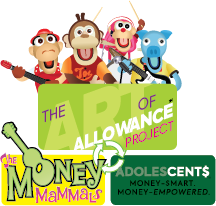
“Working to help parents raise money-smart kids.”
Hi!
My daughter graduated high school last week. I’m in reminiscing mode, so this week’s 3 Ideas to Share and Save will focus on the progression of money smarts from birth to young adulthood.
Inspired by the Psyche newsletter’s guides (Here’s their guide on how to save money.), I crafted each paragraph of this edition to address a different age and to include many useful links to help you at whatever stage you find yourself with your child — even if she hasn’t yet graduated preschool.
— 1 —
In the Years BA (Before Allowance): I joke that my book for parents, The Art of Allowance, could also be called “The Art of Money Conversation.” Way before you introduce an allowance, you’ll want to be prepared to start the money conversation with your child.
We read to our kids from day one because we know reading to them early prepares them for later literacy. This notion is called emergent literacy. An emergent property is one that becomes more than the sum of its parts, often for reasons we don’t fully understand. For example, consciousness is considered by many to be an emergent property of the human brain.
The same is true for financial literacy. I first encountered the concept of emergent financial literacy in the work of Martha McCormick and David Godsted, like this terrific report, and it has stuck with me ever since.
Open conversation is the battering ram we need to break down the taboo around the money conversation that still plagues many American families. I’m confident that more conversation will lead to improved family financial literacy outcomes. Research supports this idea.
Of course, this doesn’t mean that everything’s lost if you haven’t started a conversation by the time your kids reach school age.
— 2 —
The Allowance Years: I like to think of Kindergarten as the beginning of the allowance years, though for some families this milestone might take place a little earlier. Getting started is remarkably simple. When you’re armed with a strong why, you can set up a system that is flexible and useful and that will last and adapt with your family over time.
If you’re wondering how much allowance to start with, then here’s some food for thought. In short, this is your Art of Allowance. If you prefer live learning, then perhaps you’d like to join me in the next cohort of my Art of Allowance Academy course. Please email me back, and we’ll add you to the waitlist.
— 3 —
Adulting: When your children head to middle and then high school, they will be ready to move from the starter allowance to The Breakthrough Allowance. This “upgraded” allowance introduces some key “adulting” concepts: more responsibilities (clothes, communication, gifts and food) as well as money in larger amounts and less often (like a paycheck) so kids learn how to apportion costs throughout the month. It’s good to remember our mantra that mistakes are part of the process at this stage.
This is also the time to introduce your children to a digital allowance, as Bill Dwight, a friend of The Art of Allowance Podcast, pointed out to me years ago. Our kids need to learn to use digital money. This lesson is even more important in a post-pandemic and an increasingly cashless world. To this end, Bill’s FamZoo is an excellent place to start, as are Greenlight and Current. These are by no means endorsements. There are many options.
That’s it for this trip through the money-smart lifespan. For more information on every age and stage of the money-smart journey, be sure to check out The Money-Smart Kids Timeline available on our reimagined Art of Allowance Project website. Until next week, I wish you well as you venture forth.
John, The Chief Mammal
P.S. As always, please consult with a financial or investment professional before engaging in any decisions that might affect your own financial well-being.
Like what you just read? You can sign up for the newsletter here.

